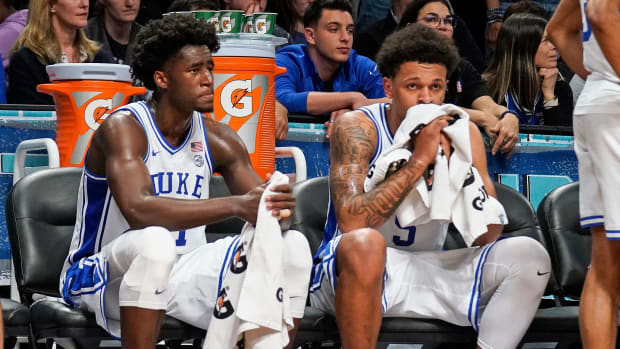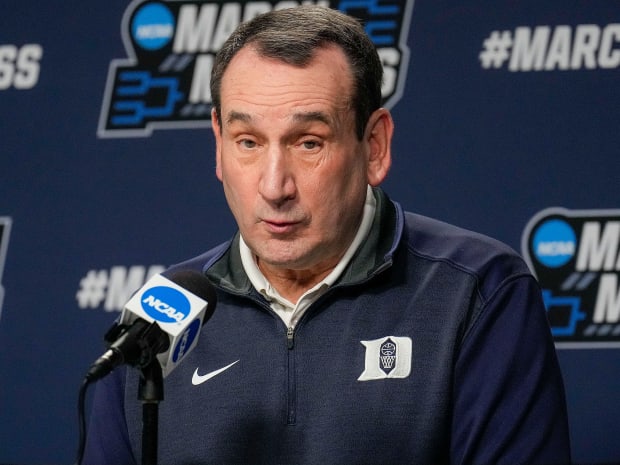Multiple stumbles of late have lowered March expectations, with precious time to get back into form for a deep run.
However it may occur, whether in New Orleans or San Francisco or, God forbid, Greenville, the end of the road draws near for Duke and Mike Krzyzewski, who, as you may have heard, is retiring. Krzyzewski has done what he can to dampen the narrative around him in an attempt to keep the focus on his very young team, which earned a No. 2 seed in the tournament having gone 28–6, a quality campaign in all respects. But as the spotlight on the Blue Devils magnifies this week, the tenor of the national conversation has been that Duke doesn’t quite have the feel of a contender, and that it isn’t quite playing its best basketball at the best time of year.
After spending last week watching Duke up close at the ACC tournament, this writer can echo that sentiment: The Blue Devils slogged their way through three tournament games, withstanding a barrage of threes from Syracuse in the quarterfinals, playing a more composed but still strenuous game against Miami in the semis and ultimately falling to scalding, confident Virginia Tech by 15 points in a game that got away from them down the stretch. Duke tips off Friday at 7:10 p.m. ET against Cal State-Fullerton, and enters the tourney with some stuff to figure out, to say the least.

John Minchillo/AP
One would think Krzyzewski’s final Duke team has more in the tank, and the hope would be that having the majority of the week to prepare should give it some extra juice headed into the weekend. A first-round win would draw the winner of Michigan State (a quasi rival Duke has battled with quite a bit over the years) and Davidson (an in-state opponent Duke hasn’t played since 2013). Advance, and it could be Texas Tech. Past that, the path most likely leads to a rematch with top overall seed Gonzaga: the Blue Devils are one of just three teams that took down the Zags, a neutral-site win that still stands as the best indicator of this group’s immense potential.
Duke starts five projected first-round NBA picks, but things are never that simple: The oldest of the group, Wendell Moore Jr., is still 20 years old, as is Mark Williams. Of the three freshmen in the rotation, Paolo Banchero is 19 and Trevor Keels and A.J. Griffin are still 18. Recall that Duke missed the 2021 tourney outright and the fact that there wasn’t one in ’20, and you’ve got a team with basically zero tournament experience. Backup center Theo John played 17 minutes in Marquette’s ’19 tourney loss to Murray State and didn’t score. It’s far from the only team with a lack of depth, but John and Jeremy Roach are the only bench players Krzyzewski trusts.
Lack of win-or-go-home seasoning is certainly not a Duke-exclusive problem in the one-and-done era, but it does kind of hang over the whole business of projecting how far the Blue Devils can actually go. In that respect, it’s probably a good thing Duke has faced adversity of late, dating back to a narratively overblown home loss against rival North Carolina on March 5 and running through the ACC tournament. Some of the cracks have been exposed in that process. Krzyzewski and his players agreed that the defensive communication was a problem against Virginia Tech’s cavalcade of screens and sets that forced Duke to constantly switch. That’s something young teams always have to work through, but it’s not great if it remains a glaring issue deep into the tournament. Duke was individually torched by Syracuse’s Jimmy Boeheim and Virginia Tech’s Hunter Cattoor, struggling to chase shooters and limit good looks.
Shoring up the defense falls on everyone, but Duke simply hasn’t presented a great deal of toughness or physicality on that end of late. Subbing in Roach for Griffin gives it a bit more tenacity in exchange for size and rebounding, a look it’s used late in games. But the Blue Devils have to have a better collective presence, first and foremost, and that starts with simple, fixable things.
This may not magically transform into an elite defensive unit, which means the Blue Devils are going to have to find a way to maximize their firepower. Duke hasn’t had many macro-level problems scoring the ball this season, boasting the seventh-best adjusted efficiency offense in KenPom and benefitting from the fact that all five of its starters are capable of giving defenses problems individually. But the issues have begun to crop up when opponents can use the shot clock to their advantage in the halfcourt and force Duke to work for better looks. Both Banchero and Griffin have a tendency to stop the ball to try and create shots, and Griffin in particular tends to struggle off the drive, when he’s not launching jumpers. Duke obviously needs those guys to score, but there needs to be less breaking off of plays and a tad bit more trust in the flow of the offense. It’s much harder to guard when it’s playing inside-out and using Williams and Banchero as targets for easy twos.
What Duke does have is two reliable stars in Moore and Williams, the former battling on the perimeter and the latter frequently changing shots and dominating the defensive glass. To get into transition, the Blue Devils have to get stops, and it can’t just be those two guys driving it. When Williams isn’t in the game, Duke not only becomes vulnerable in the paint, but also has trouble securing misses and pushing in the open court. Moore is actually Duke’s best player right now, and his athleticism and vision make him its only real weapon on the break (the trio of Keels, Griffin and Banchero isn’t all that fleet of foot). He’s at his best when Duke can run. The Moore–Williams duo performed well in the conference tournament overall, and Duke can ill afford foul trouble or a bad game from either one—Williams picked up early fouls and eventually ran out of gas in the loss to Virginia Tech. If there’s one thing clearly working in Duke’s favor, it’s that those two guys don’t have many exploitable weaknesses, giving it a better backbone than most.

Jim Dedmon/USA TODAY Sports
Stylistically, Duke is a different team than it was in November, due primarily to the emergence of Griffin, who played 30 and 36 minutes in the Blue Devils’ last two games (coming off a bout of food poisoning) and was the swing factor in the Miami game with 21 points, including a run of 12 straight by himself. They’ve needed him badly, particularly with Keels struggling to find his shot. But when Griffin’s shot isn’t falling, he tends to fade into the background, as he prefers to take set shots or create for himself on an island, and isn’t a threat to bomb off screens or force defenders to chase. The shots he likes to take don’t actually make his team that much more difficult to guard, and to some extent, opponents can live with the tough ones. But when they fall, Duke is hard to beat.
Still, assuming all other constants, it’s Banchero who will ultimately have the most say over whether the Blue Devils make the Final Four. And it hasn’t been all bad with him, either: As the season has gone on, he’s done a much better job of keeping things simple, allowing his excellent passing to open things up for teammates, putting in a more concerted effort on the offensive glass and turning in better effort on the defensive end.
The issue right now from my own observation last week is that he’s lacking confidence in his jump shot—there’s a small hitch at the top of Banchero’s release that wasn’t there early in the year, he’s missing a lot of free throws and there may not be enough time left for him to iron the wrinkles out. Those struggles make his tendency to occasionally overdribble and hunt shots that much worse, as defenders can cheat the drive and allow him to settle for tough twos. Teams will live with him taking threes right now. Of course, the Banchero we saw against Gonzaga in November is good enough to beat anybody. We’ll see whether his current run of form—which has been productive, jumper notwithstanding—is enough to keep tipping the scales in a huge game, or if the shot becomes a liability. But Duke has gone somewhat away from Banchero-at-point-guard looks in the interim, and his jumper likely has something to do with it.
It’s anyone’s guess how many of these issues Duke can iron out with a week or so to practice. It’s hard to think Krzyzewski will leave anything in the tank. Pressure notwithstanding, I think we can reasonably expect the Blue Devils to play pretty damn hard this week, which can get you to a certain point. They’re plenty good enough to make the second weekend. But without some real maturation on the fly, their run could be shorter than you think.
More March Madness Coverage:
• The Best of SI’s All-Time Coach K Coverage
• Remembering Lehigh’s Stunning Upset of Duke
• Frankie Collins Puts Michigan Back on Upswing